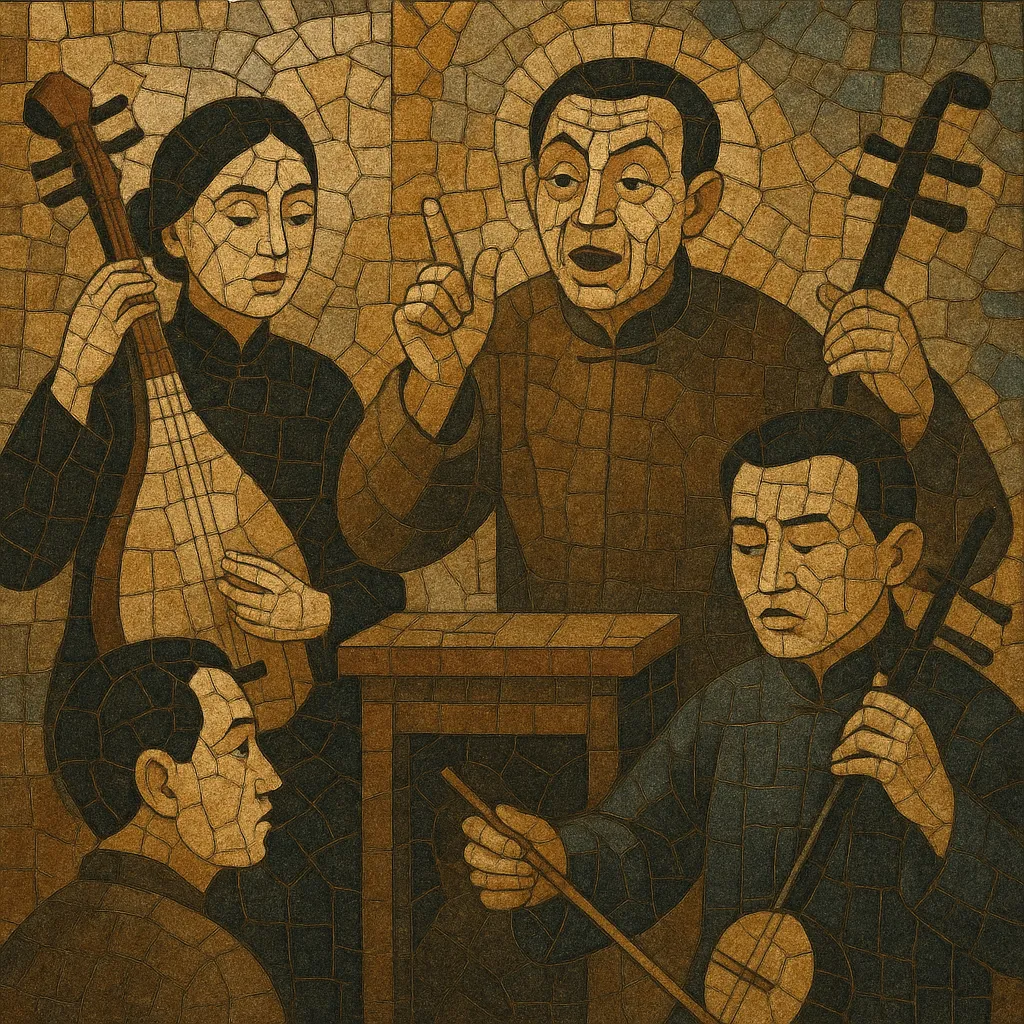Quyi is an umbrella term for China’s narrative-singing folk arts that combine spoken storytelling with sung passages and minimal instrumental accompaniment.
It encompasses many localized forms—such as pingshu (northern storytelling), pingtan/tanci (Suzhou narrative-singing), kuaiban (clapper talk), and xiangsheng (comic crosstalk)—and is typically performed in teahouses, small theatres, and on radio or television.
Musically, quyi favors pentatonic melodies, flexible speech-like rhythms, and clear prosody aligned with the tones of Mandarin or regional dialects. Performances rely on intimate delivery, witty repartee or vivid narration, and a small set of instruments (e.g., sanxian, pipa, yangqin, erhu, clappers) to paint scenes, portray characters, and pace the story.
Quyi’s roots trace back to China’s long tradition of narrative performance. Storytelling and sung recitation flourished in the Tang and Song eras in temples, markets, and teahouses, and continued to mature through the Yuan, Ming, and Qing dynasties. Over centuries, regional forms crystallized: northern pingshu developed a vivid oral storytelling style; in the Jiangnan region, pingtan/tanci blended refined Wu-dialect song with instrumental accompaniment; and rhythmic clapper talk (later known as kuaiban) became a hallmark of popular folk entertainment.
By the late 1800s and early 1900s, urban entertainment districts and teahouse culture helped quyi forms proliferate. Performers adapted historical novels and folk tales for audiences seeking both education and leisure. The emergence of recording and radio in the Republican period popularized quyi nationally, with storytellers and narrative-singing artists becoming recognizable public figures.
Following 1949, “quyi” was embraced as an official umbrella category for China’s narrative-singing folk arts. State ensembles, conservatories, and broadcasting networks documented, standardized, and promoted regional styles. While content was sometimes aligned with contemporary social themes, core performance practices—story-centered narration, song, and sparse accompaniment—remained central.
From the 1980s onward, quyi experienced renewed vitality via radio serials, television specials, and later, streaming platforms and live-club circuits. Crosstalk (xiangsheng) surged in popularity through new troupes and media-savvy performers, while pingtan and pingshu preserved teahouse traditions and found new audiences. Today, quyi remains a living ecosystem that bridges classical narrative aesthetics with modern comedic timing, media formats, and cross-genre collaborations.
Decide whether you are crafting crosstalk (xiangsheng), northern storytelling (pingshu), Suzhou narrative-singing (pingtan/tanci), or clapper talk (kuaiban). Select a concise story arc—classical tale, historical episode, or contemporary vignette—with clear characters, rising action, and a punchy resolution.
Align prosody with Mandarin or a regional dialect (e.g., Beijing, Tianjin, or Suzhou Wu). Let the music follow speech: phrases should breathe like natural conversation, with tones respected to keep lyrics intelligible. Use rhetorical devices—parallelism, alliteration, couplets, and catchphrases—to anchor refrains and jokes.
Favor pentatonic and heptatonic contours common to traditional Chinese song. Alternate between parlando (speech-like) passages and short, singable refrains. Keep rhythm flexible—rubato narration that tightens into measured patterns for punchlines, scenic transitions, or emotional peaks. For kuaiban, structure rhythmic cells around the clappers to drive tempo and audience interaction.
Use a minimal ensemble: sanxian and pipa for plucked resonance, yangqin for harmonic color, erhu for lyrical lines, dizi/xiao for ornament, and wooden clappers/ban or kuaiban for timing cues. Orchestrate sparsely so the voice and story remain foregrounded.
Maintain intimate staging, clear diction, and direct eye contact. Employ character voices, onomatopoeia, and quick shifts in timbre to differentiate roles. Time comedic beats carefully—set up, misdirection, and payoff—and invite call-and-response moments when appropriate.
Workshop pacing: trim exposition, strengthen transitions, and repeat memorable motifs. Build a personal repertory of short pieces, then expand to serialized episodes that can run across multiple performances or broadcasts.


